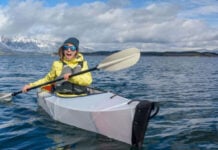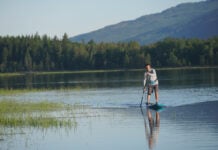Years ago, when I was working at a prominent paddlesports retailer in Madison, Wisconsin, I had a chance to try some new sea kayak paddles. They were carbon fiber with wide, compact blades and intended to be used with an upright, high-angle forward stroke. I grabbed a couple of the new paddles in 215-centimeter lengths and, for comparison, I brought a 215-centimeter paddle from a different manufacturer I had used for the past several seasons.
On the water, the new paddles were light and buoyant. They braced well and transitioned from stroke-to-stroke better than the paddle I had been using. Despite this, something felt a little strange. The catch felt different. Slower maybe. Not as assertive.
At first, I assumed this was due to the shape or size of the blade. Later, on the beach, I realized it didn’t have to do with the blades at all. It was the shaft length.
The compact blades of the new paddles were shorter than the blades of my old paddle. When I set the three paddles side-by-side on the grass, it was obvious the new paddles’ shafts were five to 10 centimeters longer than the paddle I was used to. With longer shafts, the paddles felt longer in the water. In my hand, the 215-centimeter paddle felt like a 220 or 225.
I went back inside and pulled shorter versions of the new paddles off the shelf to try, this time taking care to ensure the shaft length matched my old paddle. Back on the water, the results were dramatically different. The new paddles had a quick, assertive catch. A small change in shaft length had a significant impact on performance.
Charged-up by my discovery, I headed to the sales floor and started comparing the shaft lengths of all the paddles we had on the wall. High-angle, low-angle, and by all manufacturers. The results were illuminating.
Shaft length varied widely across models and brands at any given overall paddle length. Some paddles, with long slender blades intended for low-angle paddling, had surprisingly short shafts. Short enough to make it difficult to use them with hands held low. Others had compact blades and long shafts. The overall length of the paddle seemed to have little relationship to the shaft length, regardless of which paddle I picked up.
Why shaft length matters
This is a problem because shaft length sets the angle of the paddle during the forward stroke. In the forward stroke, you want the blade of the paddle fully immersed without burying the shaft underwater. This means a paddle with a longer shaft requires the blades placed farther from the centerline of the boat. If you’re trying to keep your hands low, you need a long shaft to allow you to get the blade fully immersed at a low angle. If you’re trying to keep the blade close to the boat for a powerful forward stroke, you need a shorter paddle shaft.
You might expect longer paddle shafts would lead to longer paddles, and vice versa, but this isn’t always the case. Kayak paddle blades optimized for low-angle paddling are typically longer and narrower than those more suited to an upright stroke. This difference can result in some confusing paddle length recommendations. The other day I worked my way through an online paddle fitting exercise to see what size the manufacturer recommended for my height and boat width. When I compared the paddles recommended, I discovered the shaft of the low-angle paddle was actually shorter than the shaft of the high-angle model.
Paddle shaft length determines how a paddle feels in use and whether it is best suited to use with a low hand position or an upright forward stroke. If all paddle blades were the same length, it would make sense to size paddles by overall length. They aren’t. Some blades are long; some are short. This means the current industry approach of sizing kayak paddles by overall length is wrong. It’s time for a better approach.
Changing the way we shop for paddles
Through trial and error, I learned what length paddle shaft works best for me. When I’m shopping for a new paddle, I compare the length of the shaft to what I’m already using. I don’t pay much attention to the overall length. My paddle quiver contains paddles varying in total length, but they feel similar in the water, regardless of whether they are 205 or 215 centimeters long.
Once you know what length paddle you prefer, it’s easy to compare shaft lengths and pick a new paddle with a similar feel. But what about people who are just getting into the sport?
A new way to size customers for paddles
It’s time for paddle manufacturers to take a page out of the footwear playbook and create a paddle shaft sizing tool similar to the metal Brannock device ubiquitous in shoe shops and used to measure feet to determine shoe size. It wouldn’t be hard to do. All you need is an adjustable length paddle shaft with no blades on it. In the kayak shop, a customer could sit on the floor or on a low stool to simulate the paddling position in her kayak. She would then hold the kayak paddle sizer and shorten or extend the length until the lower end of the sizer touched the floor and her hands were in the appropriate position for forward paddling.
For an upright stroke, the sizer would be shortened until the top hand was at shoulder level and the paddle was at a high angle. For a lower stroke, the sizer would be lengthened until the hands could be held comfortably low.
Once the fitting tool has been adjusted, walk over to the paddle wall and compare the length of the sizer to the available paddles. Pick a model with blades appropriate for your preferred forward stroke and then select the size most closely matching the shaft fitter. Don’t worry about the overall length; it doesn’t matter much.
Creating a paddle shaft sizing tool seems like a straightforward way around the wide variation in paddle shaft length found in the marketplace. If such a tool were to be commonly used, I suspect we would discover many of the paddles sold over the past couple of decades have been the wrong size.
Influencing paddle manufacturing for the better
The kayak industry is in the midst of synthesizing the best influences from the Pacific Northwest and British sea kayaking traditions. Historically, paddles used in the West Coast style have been longer and more suited to a lower angle forward stroke. Those from the British style have tended to be somewhat shorter, likely because of the influence of training in whitewater kayaks before transitioning to sea touring in the UK. Whatever the reasons, the collision of these two schools of kayaking over the past 30 years has resulted in a squeezing of paddle sizes a bit toward the middle, mostly resulting in low-angle paddles getting shorter. And this doesn’t work.
If your paddle gets too short, you can’t use it with your hands held low. You’ll bang your knuckles on the boat. After you do this a few times you’ll naturally drift toward a more upright stroke that is appropriate for the shaft length of your paddle and you won’t be using the relaxed, low-angle stroke you had intended to use.
What we’ll discover with widespread use of a paddle shaft sizing tool is low-angle paddle lengths will begin to trend longer again. I expect we’ll also see paddle lengths get shorter for high-angle forward paddling, as people discover the blades of some paddles call for much shorter shaft lengths than they had expected. And as some paddles get longer and others get shorter, kayakers will get a better fit.
Contrarian Brian Day has been paddling sea kayaks, teaching kayak skills and sharing unsolicited opinions about outdoor gear since the early ‘90s. He blogs at www.kitchi-gami.com. Please direct your rebuttals to [email protected].
Paddles may feel shorter than they appear. It’s time for paddle manufacturers to create a universal sizing tool to better fit kayakers, says writer Brian Day. | Photo: Kevin Light









Interesting thoughts here Brian. I have settled on a Werner 205cm Cyprus for my high angle blade. I had the chance to play with paddles from 205-215cm when starting. It was through testing that I found the 205 the best length for the boats I paddle – all 22″ or narrower.
I have played in a few wider boats – borrowed or tested. I always have my paddle BUT found how deep I sit in the cockpit and width of the kayak can make it feel too short for my stroke. Maybe that is just me.
I agree we need something more standardized but there will always be a bit of trial an error.
I couldn’t agree more. I use the same paddle in the same length and love it!
Thanks for your thoughts, Robert. I too paddle a 205 Cyprus much of the time. My Ikelos is a 210 and has the same length shaft as the Cyprus. Like these paddles a lot.
The Werner paddle fitter sizes me at 215 in both of these paddles, which feels too long for my tastes.
I am a 215 in Lendal or Celtic Paddles (at least the ones with the classic blade sizing). The shaft length of these paddles is the same as my 205 Cyprus and 210 Ikelos.
As a Greenland Paddler I can concur that loom (shaft) length is an important factor, for us GP’ers it driven by shoulder width and kayak width. The Greenland paddle is fitted to the paddler’s body and kayak and then is generally changed in length using varied blade lengths. The “storm” paddle is the main variation from this approach where the loom width is two fist widths to allow a sliding stroke.
Great comments and discussion on paddle length. I see way too many paddlers using very inefficient paddling posture and technique so tied to this reassessment of paddle lengths should be a reaffirmation of how important proper technique is…and dynamic, not static, based in part on the type of boat, water and paddler experience. Thanks for a good commentary.
Paddles in excessive lengths have been an epidemic in the recreation boating community, and sadly first time buyers of Sea Kayaks. These folks were often sold paddles that were 220-240cm. When you contrast how short a WW Paddle is, it is often very surprising to so many people with longer paddles that it is much more efficient for a high angle stroke to use a much shorter paddle. People using paddle that are too long end up shrugging at the end of the stroke to get the paddle out of the water, and it causes constant arm breaking to reposition back to the catch position. Using the shortest paddle possible, reduces the reaction forces on the paddler, simply because the leverage adjustment reduces the drag force from the water on the shoulders.
I recently gave a paddling buddy who has been trying to improve his forward stroke a 194 CM Werner WW Paddle, not an overly stout blade but a comparable 700cm^2. Almost immediately he stopped bending his arm, and started actively rotating. After a day of paddling with it, he noticed several things, he felt like he had more power – speed, but for the first time his obliques were barking at him, he was finally rotating. I have been using 210 Lendals for many years now. If I were to replace them I would pick either a 200 – 205 cm without hesitation. My play boat is a NDK Romany and my day / trip boat is a NDK Explorer. After a PFD, the right paddle is most important piece of properly sized gear for Kayaking. Its really not the boat that is fast, its the motor in the boat that makes it fast :).
Enjoy the rest of the year, safe and fun travels everyone!
Interesting that you discovered this about 20-25 Years after many others did. You are absolutely correct, of course. In early years of sea kayaking different blade widths and lengths pretty obviously resulted in varying shaft lengths. We used to point out to paddlers that they needed to experiment with different overall paddle lengths to find what “felt” right while paddling. Every time the paddler was able to feel the difference and made the right choice. Knowledgeable paddle shops have been doing this for years. None of this diminishes your astute observations, but it isn’t new.
Great insight, Brian! How would you account for the idea that low- and high-angle blades “catch” differently? In other words, if a low-angle blade is designed to more smoothly and gradually enter the water to full engagement, how would that affect the shaft length?
Hey Mike,
A lot of basic blade shapes seem to work OK for either style. As shapes get more specialized they appear to work a little better for for one style or the other. I think a lot of it has to do with how much curve there is in the blade from throat to tip but I’m sure there are other factors. I suppose you can use a long skinny blade on a shorter shaft but in practice I haven’t found it to work very well.
I agree 100%. I have been paddling mostly off Oregon’s coast since 1990 and had a Werner 210 Camano low angle paddle that felt a little on the short side, but mostly good, especially in surf. I switched to a 220 full carbon Camano for expeditions, which felt great touring, but too long and weak in surf. I fell in love with a carbon Greenland paddle at 218 cm, which being a Greenland paddle had a very short shaft. I did a 350 mi solo N. BC coast paddle and bought a stout high angle Aquabound at 210 cm thinking that this would be a great spare and surf paddle, but the long shaft made it paddle like a 230 cm paddle especially with my now habitually narrow grip spacing. I’ve concluded that the paddle hand should be barely above and frequently touching the water’s surface, and so shaft length is what matters.
I also question the power difference between low angle and high angle blades, thinking that blade surface area is what counts, though low hands call for longer shafts which is not ideal for max power when used in a high angle stroke.
So, at the end of the day, if you are a retailer trying to size someone for a paddle, preferably a Greenland style paddle, what steps would you take, assuming no metal devices on hand, just paddles and perhaps a chair or two?
The rules are different for Greenland paddles because the shaft length is much shorter. Standard sizing for Greenland paddles is overall length of an armspan plus a cubit (distance from elbow to fingertips). Paddle shaft (loom) should be fairly short. I always sized mine so that the shaft was about as long as my hips are wide. With this length, thumb and forefinger hold the loom and the rest of the hand is on the blade. I anticipate there are some Greenland paddle experts out there who might offer some other thoughts on sizing, but this is probably a decent place to start.
I’m intrigued to consider how to construct something like this…as a guideshop we have different paddles for use on trips, but it’d be great to do some exploring to figure out the right range of paddles to carry for our fleet boats and guests. We also sell paddles and it’d be wonderful to also help people figure out what might be the Cinderella slipper for them. I envision having a kayak seat attached to rails with foot pegs and then side rails that can slide out from the seat pan to replicate the boat width. Those sides could also be raised up/down to simulate deck height too…complicated but possible and could be used to teach basic kayaking strokes and boat fit too.